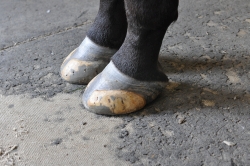There is no question that we abuse the horse’s hoof in the process of working and training them. That is the primary reason horseshoes were invented.
When training gets serious, shoeing frequency increases. This leads to hoof wall abuse in many situations. Add to that lost shoes, tweaks and changes, along with adapting to different race track surfaces, and it can get pretty serious. If we are driving more nails into the hoof wall before that wall has enough new growth to accept the nail, things begin to get tricky.
I think this was less of a problem when farriers punched the nail holes themselves and did so with each individual hoof in mind. Pre-made and pre-punched shoes lend themselves to similar nailing patterns, which, when repeated frequently, chews up the hoof.
While pre-punched shoes do offer a wide range of nailing options, the hoof’s optimal area for nailing is much smaller, as I mentioned in the January 2015 issue. When the hoof wall is gone, today’s farrier simply replaces it with glue—usually acrylic glue often incorporating the use of some kind of fiber. There are many times when this is absolutely necessary. I don’t know how farriers in the past got along without it.
Oh yes, farriers used to punch their own shoes, but let’s face it, they are not going back to those days. There is no doubt, however, that many horses in the past would have benefitted from this rebuilding of the hoof wall.
Nobody would argue the fact that acrylic and polyurethane glues have become a useful tool for the equine industry. From patching quarter cracks, to putting corrective extensions on foals, there is an ever-widening list of purposes for these products as farriers get more and more creative with them. One negative that I see is that the product becomes over-used. It has gotten to the point of being a crutch to lean on in more instances than needed. Sometimes shoes get glued on when it isn’t necessary and, in certain situations, this can be trouble.
 (Photo by the author) Fig. 1 — Adding more mass to a hoof that is already distorted outwardly will create mechanical implications in terms of balance and gait.
(Photo by the author) Fig. 1 — Adding more mass to a hoof that is already distorted outwardly will create mechanical implications in terms of balance and gait.
Traditional glue-on shoes over bruised or contracted heels is a good example of this. Traditional glue-on technique involves applying the shoe to the hoof with the primary attachment being the heel area of the hoof. This stops the normal expansion and contraction of those heels, and can be a problem with certain horses. Even sound-footed horses can have trouble if this is done too long, though I cannot think of a reason to glue shoes on a sound horse. I believe using glue-ons as a blanket fix for any hoof problem is a mistake.
Another abuse I see is that when the hoof wall gets trashy and beaten up, the farrier will add more hoof wall with glue. While this can be very helpful in situations where little or no hoof wall remains, it can be ridiculous when the existing hoof wall is a half-inch thick already and simply needs to be cleaned up. If you add more glue to this foot, it becomes quite distorted (Fig. 1). That hoof probably only needed to be dressed back to normal dimensions anyway. Adding more mass to a hoof that is already distorted outwardly will create mechanical implications in terms of balance and gait.
The ideal shoe job will protect the hoof while maintaining soundness and provide just enough traction for the situation. The key is doing this with the least amount of weight and materials as possible. Adding build ups (glue) to a hoof that doesn't need it goes against the ideal, not to mention the expense involved.
Glue addiction can be a costly thing (no, I don’t mean sniffing it). So next time the hoof starts looking a little rough around the edges take a closer look. It does not necessarily mean that you are in a sticky situation.
Veteran Standardbred farrier Steve Stanley of Lexington, Ky., authors a monthly column for Hoof Beats, the official harness racing publication of the U.S. Trotting Association. The American Farriers Journal Editorial Advisory Board member offers plenty of practical advice that will be of special interest regardless of the type of horses that you work with. Click here to read more from Steve Stanley's Hoof Beats series.








Post a comment
Report Abusive Comment